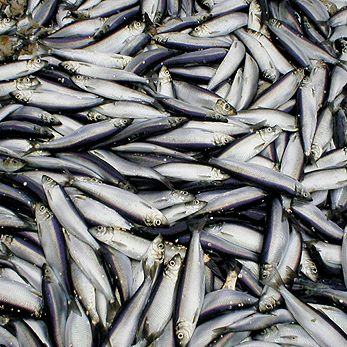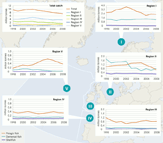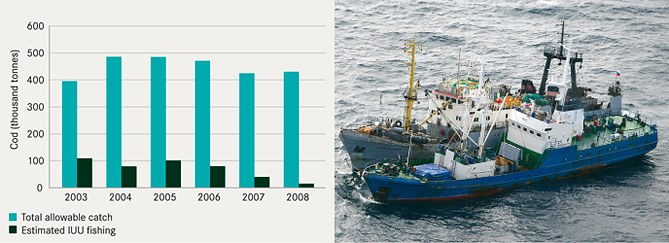Reductions in fishing fleet offset by increased efficiency
The fishing fleet capacity in the OSPAR area has been reduced. The quota systems used in Region I have helped to cut fleet size and fishing effort. The number of Icelandic demersal trawlers and trawling effort has almost halved since 1990, with a 25% decline in engine power and an equivalent decrease in gross tonnage. In the same period the number of fishing vessels in Norway has reduced by 43%, and fishing fleet tonnage and engine power have decreased by 10%. Efforts to reduce fleet capacity in EU waters have seen a total decrease in vessel numbers of 26.7% in the period 1995 to 2009. Tonnage and power have fallen correspondingly. Reductions in vessel numbers, size and engine power have, however, tended to be offset by technological advancements allowing improved fishing efficiency.
Fishing effort is falling in some areas but increasing in others
In Region I, the closure of large areas in Norwegian waters to fisheries has contributed to a reduction of effort. In the Faroe Islands, the number of fishing days allocated has been cut by 33% since 1996.
Overall fishing effort in Region II fell by about 25% between 2000 and 2006. In the North Sea, beam and otter trawl fishing effort decreased by 31% and 44% respectively between 1997 and 2004, although Nephrops trawl effort grew by 65%. Beam trawling has been increasingly replaced by twin-rigging and flyshooting, which require less fuel. In the western Channel, fishing effort increased over the period 2000 to 2007, mainly driven by the use of gears that are not covered by effort limitations, and trawl effort is high.
In Region III, there has been a fall in trawl effort in the Irish Sea and to the west of Scotland, but overall fishing effort has stayed high. Some beam trawlers have switched to otter trawling or to scallop dredging, a non-quota fishery.
In Region IV, the number of French vessels fishing in the Bay of Biscay fell between 2000 and 2006, with the exception of liners and gillnetters. However, the fishing effort increased or remained stable for each sector, apart from the anchovy fishery, which was closed from 2005 to 2009. This stability in effort contrasts with an observed decrease in fishing mortality for most fish stocks in the Bay of Biscay. This may be a result of more stocks that are not assessed being targeted or a decrease in fishing efficiency from use of more selective gear.
Management measures for deep-sea fishing effort were first introduced in 2004, including a deep-water licence scheme and TACs. Effort reductions have been in place since 2005. Effort reduction on deep-sea species should lead to a fishing effort level in 2009 which is 65% of the ceiling defined in 2003.
EU effort management regimes cover the major part of the OSPAR area. An assessment of the effectiveness of these regimes is underway.
Landings have fallen overall but trends vary
The total landings of demersal fish, pelagic fish, and shellfish fell between 1998 and 2008 Figure 8.3. However, a progressive decrease is only observed after 2002. Between 1998 and 2002 the total catch was more variable with a moderate increase observed between 1999 and 2002. Only in Region V were more fish and shellfish landed in 2008 relative to 1998.
One of the reasons for the overall decline in landings is the definition of more restrictive catch limits. There has, however, been considerable variation across the Regions. In Region I, demersal landings were relatively stable over the period, while landings of pelagic fish and shellfish declined. In Region II, demersal landings continued to increase until 2005, but have since declined such that in 2008 the catch was lower than in 1998. Pelagic catch has decreased throughout the decade. In Region III, pelagic landings fell to a minimum in 2002. Since then there has been a slight increase, but the landings of pelagic fish in 2008 remain lower than in 1998. Demersal landings in Region III have remained relatively constant. In Region IV, landings showed little change. The greatest increase in landings occurred in Region V, with pelagic landings rising from around 0.2 million tonnes in 1998 to over 0.6 million tonnes in 2005. However, since then pelagic landings have fallen to around 0.39 million tonnes. These trends have been mainly due to the development of the blue whiting fishery for which a TAC was agreed in 2005.
Controls on discards are tightening
It is too early to assess the effect of recent action in EU waters on discards, and discard rates have remained high in some EU fisheries until very recently, with, for example, extensive discarding having been reported in many roundfish, flatfish, and Nephrops fisheries in the North Sea and some similar fisheries in Regions III and IV. There are indications that discard rates may have increased where stocks comprise a high proportion of juvenile fish. There has been some success in reducing discard rates in EU Crangon trawl fisheries as a result of measures requiring the use of sorting devices.
In Region I, discard bans have been in place in Norwegian, Faroese and Icelandic fisheries since the 1990s with side-measures that discourage high-grading. Sorting grids have become widely used in demersal fisheries in Region I to limit the catch of juvenile or other stocks. The most successful programmes for reducing discards have been those developed in close collaboration with industry. For example, in the blue whiting fishery around the Faroe Islands, use of sorting grids became mandatory in 2007 to avoid by-catch of saithe and cod. This measure was developed in collaboration with the fishing industry and supported by education programmes and grants for equipment. Monitoring suggests that the by-catch has been reduced successfully. Also, OSPAR countries are using surveillance programmes aimed at monitoring the proportion of undersized fish in catches. When the proportion exceeds a certain limit, fishing areas are closed for some time with immediate effect.
Further efforts are needed to reduce by-catch of marine mammals
Despite many efforts to reduce the by-catch of non-commercial species, including sharks and marine mammals, not all measures are efficient. More must be done to reduce mortality and improved observer programmes are needed. Some threatened shark species have a zero TAC in EU waters, but awareness and catch identification can be poor. Some species that were previously fished commercially and which are now seriously depleted, such as common skate in Region III, have become by-catch in fisheries targeting more abundant species. In some cases, markets have developed for former by-catch species (e.g. blue shark in oceanic pelagic fisheries); these species are now considered part of the target catch and are mostly retained.
Harbour porpoises, dolphins and seals are still commonly entangled in fishing gear. Mortality rates for harbour porpoises caught in gillnets, and common dolphins caught in pelagic trawl nets continue to cause concern. Cetacean by-catch rates in the driftnet fishery for albacore tuna were addressed when it was banned in 2002 and driftnets were later banned in all EU waters. However, as a consequence pair trawling has developed in some areas, which also has by-catch implications. Research into mitigation measures is ongoing. Results from the use of acoustic deterrents (pingers) have been mixed.



